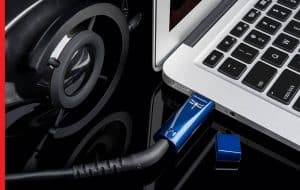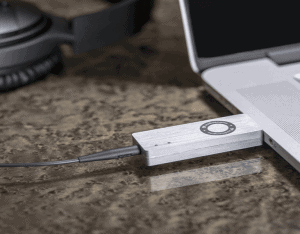All sorts of enjoyment can be attained by DACs like Audioengine d3 and dragonfly. After the introduction of these products, music and video production became ‘real’ art. However, drawing robust comparisons between the two has never been easy. Therefore, this article will try to provide you with all the necessary facts you might need to know about the two tiny amplifiers.
Knowing exactly what you need from a certain electronic is always advisable for impressive performance. You will only know when Audioengine d3 is better than dragonfly or vice versa with comprehensive details. Let’s have a look at each product and square out unique features.
Table of Contents
DragonFly Red review
When the first DragonFly was launched into the market in the year 2012, many people breathed fresh air. Headphone amp and DAC combined to form something like a USB stick? That’s amazing and a serious innovation.

Features
AudioQuest comes with a lot of elegant features, setting it far from its counterparts on the market. However, some customers have criticized the Dragonfly range, asserting that its high-resolution music support is 24-bit/96kHz. The black model restores that limitation, but then it’s exceptionally affordable.
AudioQuest comes with some upgrades like advanced headphones and a DAC amp for beginners and perfect upgraded volume control on the DAC. Furthermore, the 2.1v voltage output in DragonFly is excellent, making it perfect for running demanding headphones.
Overall performance
The DragonFly Red comes with improved sounds, at only 80 pounds. The black model comes with a bit improved plugging connectivity as you can easily connect your headphones to the laptop’s headphone port. This feature is a bit sophisticated when it comes to Red models, but they all do wonders once connected. Furthermore, the bass extension of this device is impressive and also its body is impressive. You will also find three-dimensionality, texture, and solidity to each sound, making DragonFly sound relatively two-dimensional.
More so, being fuller-bodied, the gadget boasts a more detailed deal. The combination with great low-level dynamics implies the more natural, expressive, and subtle sound in this model. The DragonFly allows you to connect it to various mobile devices like smartphones and Android. This allows you to enjoy every bit of life around your home.
Design
The design of DragonFly is attractive, but some lads have complained about earlier chips. The glossy red design finishing is what I am referring to. But, the package comes with a pouch for easy and safer transportation. But still, some individuals aren’t satisfied with its blemished nature when accidentally roughed up on the road.
The device itself is supremely convenient and compact, allowing you to carry it with you anywhere for musical boots. The logo lights up in various colors, giving you a ‘live’ experience or mind-easing information.
Audioengine D3 review
Audioengine D3 sounds fine, but some prominent rivals perform better.

Build quality
The aluminum case in this device makes it substantial and held together using smaller bolts. The Audioengine feels and looks relatively solid with a strong case, resisting any damage attempt. This art is unlike Dragonfly with its glossy finish. However, sometimes you might be a bit disappointed by the absence of a similar aluminum end-cap for protecting the USB connector once it is not in use.
Just like the DragonFly, D3 is equipped with a woolly-Esque carrying pouch, suitable for maintaining its warmth, especially in cold months. It also comes with a complete and understandable guide for easy operation. Any 6.3mm headphone connector is compatible with the 3.5mm output of the Audioengine D3.
When it comes to compatibility, D3 can pair with windows computers and Apple Macs, and it doesn’t require any extra drivers. Like the DragonFly, the Audioengine can handle up to 24-bit/96kHz natively sample rates. More so, the Audioengine D3 supports asynchronous data movement between the Audioengine and the USB output of your computer, specifically for enhanced sound performance.
On the stick, there are two small indicators; when the Audioengine is in use, the external light glows blue. The internal light will glow white, implying that the DAC is on and ready for data. Unlike the AudioQuest DragonFly v1.2, the Audioengine operates without external volume controls. Rather, it is supported by the music software with you.
Sound quality
This device favors unfussy and direct sound, extracting an excellent track’s level detail. On top of that, the Audioengine boasts a brooding bass that hits with an impressive impact sense superior claps to litter the well-defined and concise track sound. However, many lads would wish a little bit more texturing and detail of notes.
There is also no refinement to its general sound that ruins the joy and gloss of music. Some people say that the D3 isn’t as believable or natural as the Audioengine DragonFly when playing some songs. More so, the tune does not show the exact sonic subtitles and it doesn’t have the real emotional impact compared to DragonFly.
Frequently asked questions (FAQ)
What do customers say about DragonFly’s features?
The device combines all mids, highs, and lows into an exciting and warm sound. Its tones are complete and rich, there’s nothing lost on the scale. The sound you get by using this audio stick is non-fatiguing, making it great to be used in streaming YouTube videos and HD tracks.
What do customers say about the D3’s weight?
The unit is tiny and compact and comes with a carrying pouch for easy transportation. Some folks have asserted that you enjoy moving around with this sound stick because it’s more portable. It beats the Audioengine D1 and because of its minimalist design, takes it as your wallet. Believe me, you won’t get a portable DAC and amplifier of this and weight.
Final words
The Audioengine D3 is quite a robust device, but it fails sonically to attract your attention; it lacks a long-lasting impression. The DragonFly itself is supremely convenient and compact, allowing you to carry it with you anywhere for musical boots. The logo lights up in various colors, giving you a ‘live’ experience or mind-easing information.
When it comes to price, the Audioengine D3 is much far better than the DragonFly. This implies that you can still enjoy quality and subtle music at a less-priced stick.
